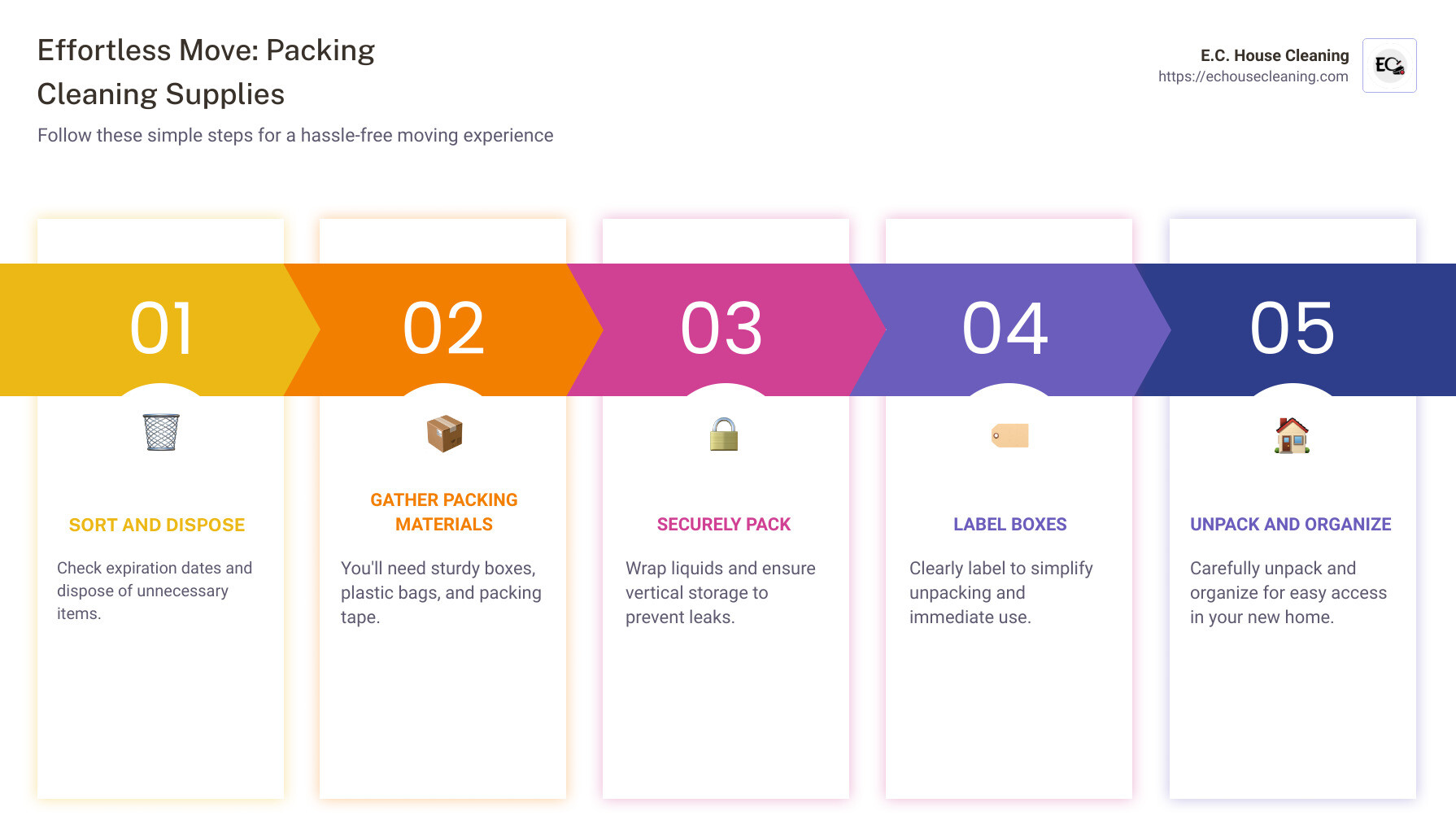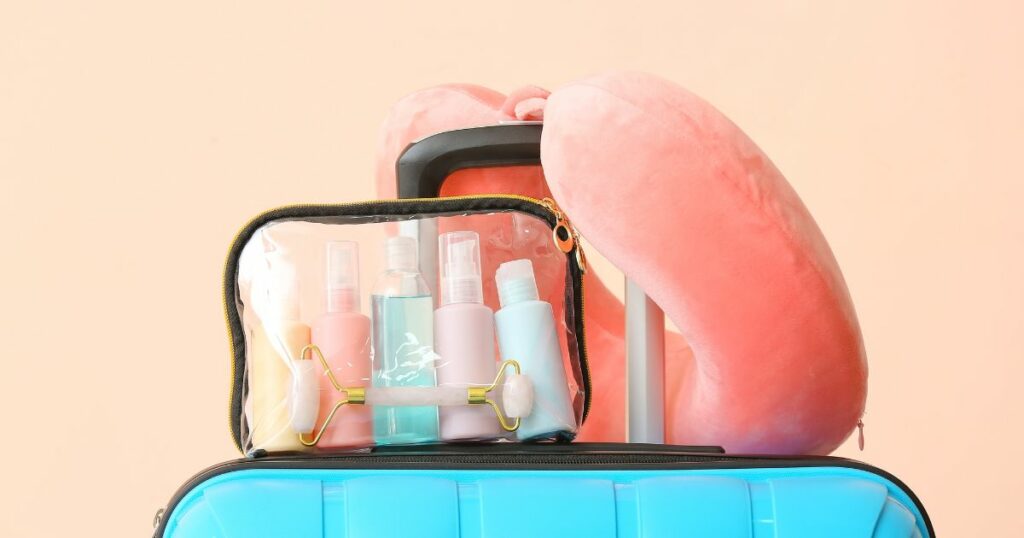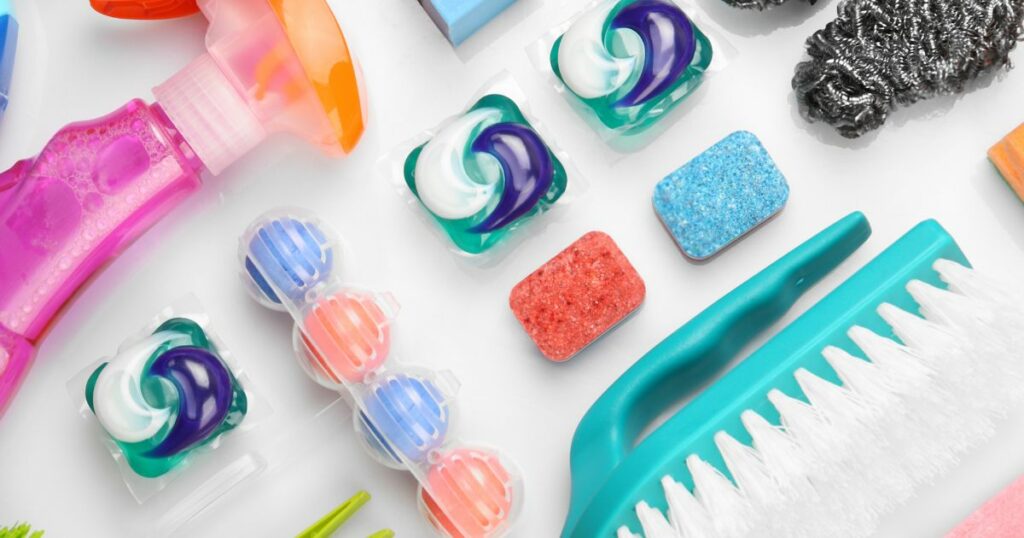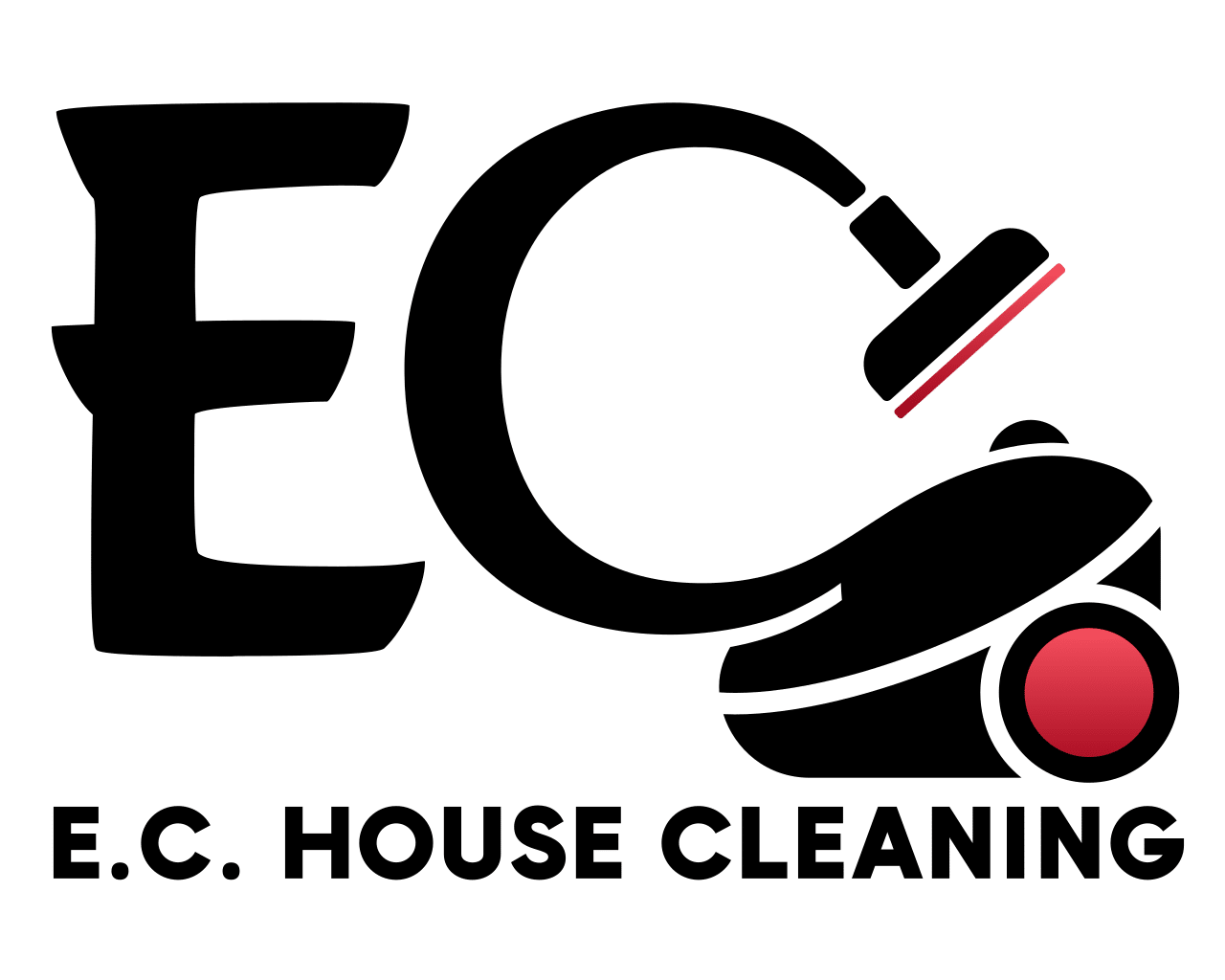Moving your cleaning supplies the right way is essential to avoid spills, waste, and last-minute store runs in your new home. Moving to a new home can be overwhelming, especially when it comes to the smaller details like packing cleaning supplies.
Not only are these supplies crucial for cleaning your old space before moving out, but they’re also necessary for maintaining a clean environment from the moment you step foot into your new home.
With busy professionals and families in Massachusetts in mind. This article promises to deliver straightforward and efficient methods for packing cleaning supplies.
Our goal is to guarantee that your move is as smooth and secure as possible by preventing any unnecessary spills, avoiding the need to replace costly supplies, and ensuring your cleaning essentials are on hand the moment you arrive at your new residence.
Checklist: How to Pack Cleaning Supplies for Moving
- Sorting your supplies by expiration and use.
- Disposing of unwanted or expired items properly.
- Gathering necessary packing materials like sturdy boxes and plastic bags.
- Packing items carefully, paying extra attention to liquids.
- Labeling boxes to make unpacking easier.
This guide will walk you through each step, ensuring you’re ready to clean your new space without any hitches. To start, we’ll emphasize the importance of sorting through your supplies and identifying which items are essential and which can be left behind.

By following this guide, you’ll not only save time and money but also ensure your new home is sparkling clean from day one, all while prioritizing health and environment-friendly practices.
Table of Contents
Sorting and Disposing of Cleaning Supplies
When you’re gearing up for a move, how to pack cleaning supplies for moving starts with a critical first step: sorting and disposing. This step is not just about efficiency; it’s about safety and environmental responsibility too. Let’s dive into how you can tackle this task effectively.
Expiration Dates
Just like food, cleaning supplies don’t last forever. Before you start packing, take a moment to check the expiration dates on all your cleaning products. You might be surprised to find that some of your supplies are past their prime. Using expired cleaning products can be ineffective and, in some cases, dangerous.
Proper Disposal
Proper disposal of cleaning supplies is crucial. Many cleaning products contain chemicals that can harm the environment if not disposed of correctly. Here’s a simple rule to follow: never pour cleaning supplies down the drain, onto the ground, or into storm sewers.
Instead, contact your local waste management department.
Many communities offer collection days for hazardous household waste, including cleaning chemicals and supplies. This ensures that these chemicals are disposed of in a way that’s safe for the environment for most people.
Combining Products
You might find yourself with two half-empty bottles of the same product. While it might seem like a good idea to combine them to save space, this can be risky. Some products, even if they seem similar, can react with each other when mixed, potentially creating dangerous chemicals.
Always read the label to see if combining is safe. If in doubt, it’s better to err on the side of caution and keep them separate.
Remember:
- Check expiration dates and dispose of any products that are out of date.
- Follow proper disposal methods for products you can’t take with you. This might mean taking them to a hazardous waste collection day in your community.
- Be cautious about combining products. When in doubt, don’t mix.
By sorting and disposing of your cleaning supplies responsibly, you’re not just making your move easier. You’re also ensuring that you’re not contributing to environmental harm. Plus, this process allows you to start fresh in your new home, with only the supplies you really need and use.
As we move into the next section on the essential packing materials you’ll need, keep these sorting, packing liquids, and disposing tips in mind. They’re the foundation for a smooth, safe, and eco-friendly move.
Essential Packing Materials

When you’re learning how to pack cleaning supplies for moving, it’s crucial to have the right materials on hand. These materials ensure that your supplies and containers are packed securely, minimizing the risk of spills and leaks during the move. Here’s what you’ll need:
Sturdy Boxes
Choose strong, sturdy boxes that you hope can hold the weight of your cleaning supplies without buckling or tearing. It’s a good idea to use smaller boxes rather than larger ones, as this makes them easier to pack and carry and reduces the chance of overpacking.
Plastic Bags
Heavy-duty plastic bags or garbage bags can be used as an additional layer of protection for your cleaning supplies. They can catch any accidental leaks and prevent them from spreading to other items. For extra security to prevent leaks further, consider using plastic bins or double-bagging your most leak-prone products.
Packing Tape
High-quality packing tape is essential for sealing your boxes and bags. Make sure to tape not only secure not just the top and bottom flaps but also the seams of the plastic wrap around the boxes for added strength.
Bubble Wrap
Bubble wrap provides cushioning for your more fragile cleaning supplies, such as glass bottles of cleaner or aerosol cans that could dent. Wrap individual items or group a whole pack or box of smaller items together in a single layer of bubble wrap before placing them in their box or bag.
Wrapping, Labeling, and Storing Cleaning Supplies
Packing cleaning supplies for moving doesn’t have to be a headache. With the right approach, you can ensure your cleaning essentials arrive at your new home safe, sound, and ready to use. Let’s dive into some simple yet effective strategies.
Wrapping Liquids
When it comes to liquids, the last thing you want is a spill. To avoid this:
- Secure the Lid: Make sure each bottle’s lid is tightly closed. For extra security, apply tape over the lid.
- Wrap in Plastic: Use plastic wrap to individually wrap each container. This acts as a second barrier against leaks.
Vertical Storage
Always store liquid containers vertically. This minimizes the risk of leaks and spills during the move. If you’re using a full plastic bag, plastic bin or box:
- Place each wrapped bottle standing up.
- If there’s extra space, fill it with packing paper or towels to keep the bottles from tipping over.
Labeling
Labeling is crucial. Not only does it help you find what you need quickly at your new home, but it also alerts you and movers of prohibited items to handle with care. Here’s how to do it right:
- Use a marker to clearly label each box or bin with “Cleaning Supplies” and “Fragile.”
- Include a note on the contents, especially if there are hazardous materials inside.
Hazardous Materials
Some cleaning supplies are considered hazardous and require special attention:
- Know What’s Hazardous: Products like bleach, ammonia, and certain aerosols can pose risks. Check the labels for any hazardous symbols.
- Pack Separately: Keep hazardous materials in their own box or bin. This way, if there’s a spill, it won’t contaminate everything else.
- Consider Leaving Behind: For long-distance moves, it might be safer to dispose of hazardous materials and purchase new ones upon arrival.
By following these tips, you’re not just ensuring the safety of your cleaning supplies during the move; you’re also protecting your other belongings and making unpacking a breeze. The goal is to make your transition to your new home as smooth and spill-free as possible.
Special Considerations for Long-Distance Moves

When you’re moving your home from one place to another, especially over long distances, there are a few extra things to think about. This is especially true for your cleaning supplies.
Let’s dive into how to handle temperature changes and hazardous conditions during the move.
Temperature Changes
Moving trucks can get really hot or really cold inside, depending on the weather. This can be a problem for some cleaning products and supplies. For example, if it gets too cold, liquid cleaning products, might freeze and then expand, causing their containers to break. On the flip side, too much heat can make some chemicals give off dangerous fumes or even cause them to explode.
Tip: Try to keep your cleaning supplies in a temperature-controlled environment as much as possible. If you’re moving during extreme weather, consider using moving containers for these items in your own vehicle where you can manage the back room temperature better.
Hazardous Conditions
Long-distance moves mean your belongings will be on the road longer, which increases the risk of accidents. If cleaning supplies spill or leak, they can create slippery surfaces or toxic environments for anyone handling the boxes.
Tip: Clearly label boxes with cleaning supplies as “Hazardous” and list the contents. This way, your own professional moving company or movers will know to handle these boxes with extra care. Also, inform your professional moving company about these items in advance so they can take the necessary precautions.
Remember: For long-distance moves, it might be safer and more cost-effective to use up, give away, or properly dispose of larger, partially used, or high-risk cleaning supplies before you move. You can always buy new supplies when you arrive at your new home.
Moving cleaning supplies requires careful planning and packing, especially for long-distance moves. By considering temperature changes, potential leaks, chemical reactions, and hazardous conditions, you can ensure a safer move for everyone involved.
Conclusion
We’ve journeyed through the essentials of how to pack cleaning supplies for moving, covering everything from sorting and disposing to packing and unpacking. It’s clear that with a bit of planning and the right techniques, you can ensure that your cleaning supplies arrive at your new home safely and ready for use.
Safety cannot be overstated when it comes to moving cleaning supplies. These items, while everyday essentials, can pose risks if not handled correctly. Leaks, spills, and chemical reactions are not just potential messes but hazards. That’s why we emphasized proper packing, labeling, and the careful transportation of these items.
Contact us at E.C. House Cleaning, we understand the importance of a clean and organized home. Moving presents a perfect opportunity to reassess your cleaning supplies, ensuring that you’re starting fresh, with products that are safe, effective, and organized to your liking.
Frequently Asked Questions about Packing Cleaning Supplies
When it comes to how to pack cleaning supplies for moving, several common questions come up. Let’s dive into these and provide some clear, simple answers.
Can I pack all types of cleaning supplies?
Not all cleaning supplies are created equal, especially when it comes to moving them. Hazardous materials like bleach, aerosol cans, disinfectants, and anything with ammonia or acids should not be packed in your moving boxes.
Most other moving trucks and companies have strict rules against transporting these due to the risk of leaks and chemical reactions during the move. Always check the label for any specific moving instructions or warnings.
What should I do with cleaning supplies I can’t move?
If you find yourself with cleaning supplies you can’t move, consider a few options:
- Use them up before you move. Plan a final deep clean of your current home using the supplies you have.
- Give them away to friends, family, or neighbors. Someone else might need what you can’t take with you.
- Donate them. Some charitable organizations, shelters, or community centers might accept cleaning supplies, especially unopened ones.
The goal is to avoid waste while also ensuring the safety and ease of your move. By carefully selecting what to take, how to pack it, and responsibly disposing of what you can’t, you’re making a positive step towards a smooth transition to your new home.
Our Content
All content is written by E.C. House Cleaning’s professional residential moving cleaners. We put our expertise in house cleaning services into each piece of content, focusing on providing valuable, accurate, and relevant information. With over 20 years of deep, full cleaning service industry experience in the Massachusetts and Boston area with a proven track record of pet-friendly cleaning services in Massachusetts and trust for customers as signaled by our hundreds of 5-star reviews, E.C. House Cleaning is an authority on residential and commercial cleaning services.
